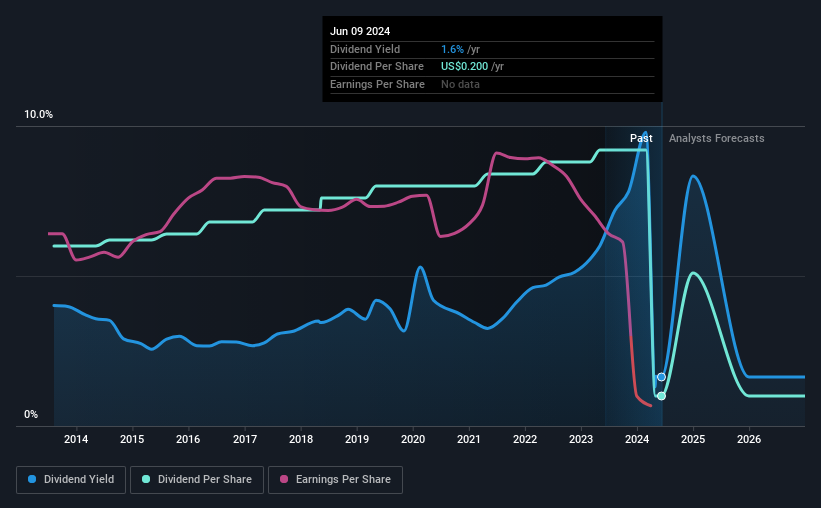It Might Not Be A Great Idea To Buy Leggett & Platt, Incorporated (NYSE:LEG) For Its Next Dividend
Leggett & Platt, Incorporated (NYSE:LEG) is about to trade ex-dividend in the next four days. The ex-dividend date is one business day before the record date, which is the cut-off date for shareholders to be present on the company's books to be eligible for a dividend payment. The ex-dividend date is important because any transaction on a stock needs to have been settled before the record date in order to be eligible for a dividend. Therefore, if you purchase Leggett & Platt's shares on or after the 14th of June, you won't be eligible to receive the dividend, when it is paid on the 15th of July.
The company's next dividend payment will be US$0.05 per share, and in the last 12 months, the company paid a total of US$0.20 per share. Looking at the last 12 months of distributions, Leggett & Platt has a trailing yield of approximately 1.6% on its current stock price of US$12.24. Dividends are an important source of income to many shareholders, but the health of the business is crucial to maintaining those dividends. So we need to check whether the dividend payments are covered, and if earnings are growing.
Check out our latest analysis for Leggett & Platt
If a company pays out more in dividends than it earned, then the dividend might become unsustainable - hardly an ideal situation. Leggett & Platt lost money last year, so the fact that it's paying a dividend is certainly disconcerting. There might be a good reason for this, but we'd want to look into it further before getting comfortable. Considering the lack of profitability, we also need to check if the company generated enough cash flow to cover the dividend payment. If cash earnings don't cover the dividend, the company would have to pay dividends out of cash in the bank, or by borrowing money, neither of which is long-term sustainable. It paid out 83% of its free cash flow as dividends, which is within usual limits but will limit the company's ability to lift the dividend if there's no growth.
Click here to see the company's payout ratio, plus analyst estimates of its future dividends.
Have Earnings And Dividends Been Growing?
Businesses with shrinking earnings are tricky from a dividend perspective. If earnings decline and the company is forced to cut its dividend, investors could watch the value of their investment go up in smoke. Leggett & Platt reported a loss last year, and the general trend suggests its earnings have also been declining in recent years, making us wonder if the dividend is at risk.
Another key way to measure a company's dividend prospects is by measuring its historical rate of dividend growth. Leggett & Platt's dividend payments per share have declined at 16% per year on average over the past 10 years, which is uninspiring. It's never nice to see earnings and dividends falling, but at least management has cut the dividend rather than potentially risk the company's health in an attempt to maintain it.
Get our latest analysis on Leggett & Platt's balance sheet health here.
The Bottom Line
Has Leggett & Platt got what it takes to maintain its dividend payments? First, it's not great to see the company paying a dividend despite being loss-making over the last year. On the plus side, the dividend was covered by free cash flow." Bottom line: Leggett & Platt has some unfortunate characteristics that we think could lead to sub-optimal outcomes for dividend investors.
With that in mind though, if the poor dividend characteristics of Leggett & Platt don't faze you, it's worth being mindful of the risks involved with this business. For instance, we've identified 2 warning signs for Leggett & Platt (1 doesn't sit too well with us) you should be aware of.
A common investing mistake is buying the first interesting stock you see. Here you can find a full list of high-yield dividend stocks.
Have feedback on this article? Concerned about the content? Get in touch with us directly. Alternatively, email editorial-team (at) simplywallst.com.
This article by Simply Wall St is general in nature. We provide commentary based on historical data and analyst forecasts only using an unbiased methodology and our articles are not intended to be financial advice. It does not constitute a recommendation to buy or sell any stock, and does not take account of your objectives, or your financial situation. We aim to bring you long-term focused analysis driven by fundamental data. Note that our analysis may not factor in the latest price-sensitive company announcements or qualitative material. Simply Wall St has no position in any stocks mentioned.

 Yahoo Finance
Yahoo Finance 
